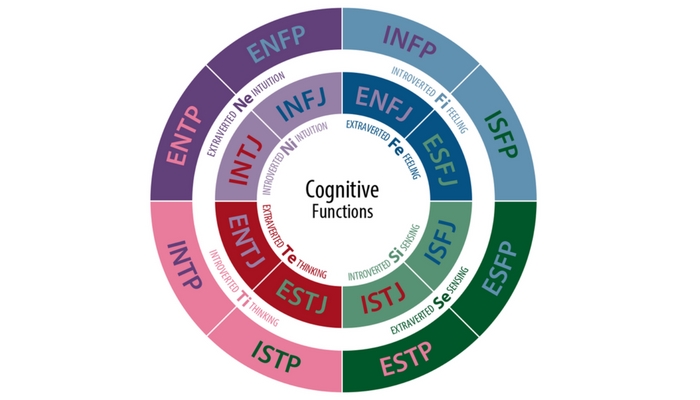4 Basic Cognitive Functions of MBTI & Their Orders
The Myers-Briggs Type Indicator or MBTI is a psychometric questionnaire that measures the individual’s psychological preferen...

The Myers-Briggs Type Indicator or MBTI is a psychometric questionnaire that measures the individual’s psychological preferences about how someone perceives the world and makes life’s decisions. These specific preferences are based on a person’s underlying needs, values, motivation, and interests.
Designed by Katharine Cook Briggs and her daughter Isabel Briggs Myers, MBTI is based on Carl Jung’s theories of personality type. Jung theorized that there are four basic cognitive functions namely thinking, sensation, feeling, and intuition.

In the MBTI model, the four dichotomies were defined viz. extraversion (E)/introversion (I), intuition (N)/sensing (S), feeling (F)/thinking (T), and perception (P)/judging (J). The irrational (or perceiving) functions are sensation and intuition, and judging (or rational) functions are feeling and thinking.
Moreover, each of these functions can take either of the two attitudes, introverted and extroverted. In all, there are 16 personality types based on the side of dichotomy people belong to and they are labeled by four respective letters (for example INTJ, ESFP, etc).
Now let’s know about these four basic MBTI cognitive functions in detail.
1. Sensing

Sensing is the perceiving (irrational) cognitive function that is about the concrete perception of the environment. The sensing types prefer a learning environment wherein the material is put forward in a thorough and ordered manner. They pay heed to the present occurrences and move to the abstract only after establishing a concrete experience.
Si and Se are the two orders of sensing function in which Si is introverted sensing and Se is extraverted sensing. Extraverted sensing or Se is the sensing function that perceives a phenomenon pragmatically and concretely. Introverted sensing or Si is the sensing function that perceives a phenomenon the same as a Se does but in a subjective manner.
2. Intuition

Intuition is the perceiving (irrational) cognitive function that is about the abstract perception of the environment. The intuitive types enjoy a learning environment wherein emphasis is laid on meaning and associations. They value insight more than careful observation and pattern recognition occurs naturally to them.
Ni and Ne are the two orders of intuition function in which Ni is introverted intuition and Ne is extraverted intuition. Introverted intuition or Ni is the type of intuition acting in an introvert and takes place in a subjective manner. Extraverted intuition or Ne is the intuition that introspects in an extrovert and is of objective manner.
3. Thinking

In impersonal assessment, thinking is the judging (rational) cognitive function. The thinking types look for objective truth and logical principles, and deductive reasoning comes naturally to them.
Ti and Te are two orders of thinking function in which Ti is introverted thinking and Te is extraverted thinking. Extraverted thinking or Te is the type of thinking function that is objective (extroverted disposition) and usually applies inductive reasoning. Introverted thinking or Ti is the type of thinking function that is subjective (introverted disposition) and usually applies deductive reasoning.
4. Feeling

In a person-centered assessment, the feeling is the judging (rational) cognitive function. The feeling types lay emphasis on issues and causes that can be individualized considering other people's motives.
Fi and Fe are two orders of feeling function in which Fi is introverted feeling and Fe is extraverted feeling. Extraverted feeling or Fe is the feeling function that is predominantly concerned with connection and commonality to others. Introverted feeling or Fi is the type of feeling function that is primarily concerned with trustworthiness, personal values, and originality.
Popular Posts
What Is Trypophobia – A Disgust More Than Fear
"I can't really face small, irregularly or asymmetrically placed holes, they make me like, throw up in my mouth, cry a little bi...
Chandan Roy
16 Interesting Facts About Ambidextrous People
A lefty or left-handed uses his left hand more naturally and dominantly than the right hand. And the righty or right-handed is o...
Ethan Stephans
20 Interesting Facts About Meteoroid, Meteor and Meteorite
Watching celestial objects is a true delight. It is still fun to catch a sight of shooting stars when we grow up. A second of th...
Swati Bhandari








